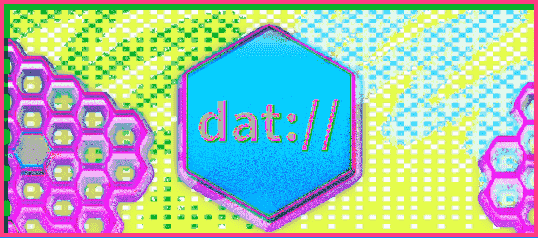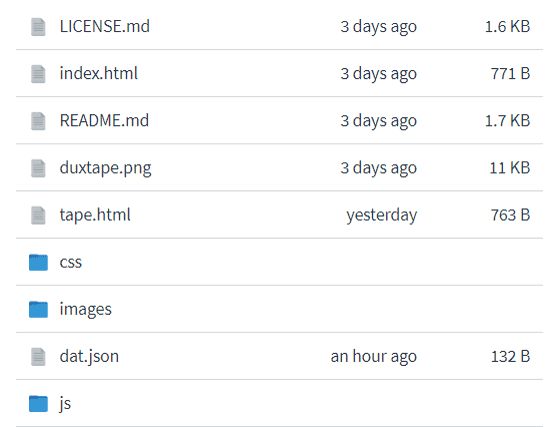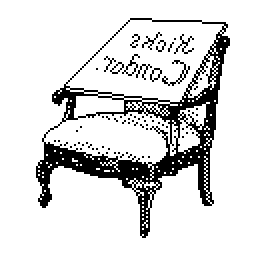

On Dat://
My teardown of Beaker and the Dat network.
We’re probably all scrambling to figure out a future for ourselves—either by hunting around for some shred of promising technology or by throwing up our hands—shouting and retreating and dreading the shadow of the next corporate titan descending from the sky. The prolonged lifespans of distributed protocols like Bitcoin and torrents means we’re maybe skeptical or jaded about any new protocols—these types of protocols are becoming old news. Maybe we’re just hunkered down in some current online bucket.
And I’ve felt this too—ActivityPub and Secure Scuttlebutt are too complicated. Tim Berner-Lee’s Solid is—well, I can’t even tell what it is. I don’t want to hear about blockchain: do we really need a GPU mining war at the center of our new Web? These are all someone’s idea of a distributed Web, but not mine. IPFS is really cool—but how do I surf it?
After discovering the Beaker Browser, a Web browser for the distributed Dat network, I felt that there was some real promise here. It was simple—load up the browser, create a website, pass your link around. There’s not much new to learn. And the underlying technology is solid: a binary protocol very similar to Git.[1] (As opposed to Secure Scuttlebutt, which is tons of encrypted JSON.)
I spent four months using Beaker actively: running this website on the network, messing with the different libraries, trying out the different apps—and then I hit a wall. Had a good time, for sure. And I kept seeding my Dats—kept my sites on the network. The technology was just lovely.
But: you can’t yet edit a website from a different browser (like on a different computer). This is called multi-writer support—and there is some talk about this landing by the end of the year. But this is, from what I can see, the single major omission in Beaker. (It’s not a problem with Dat itself—you can use a Hyperdb for that—but Beaker hasn’t settled the details.)
So I left Dat alone. I figured: they need time to work this problem out. Beaker has remained remarkably effortless to use—I’d hate for multi-writer to be tacked on, complicating the whole thing.
An Imperfect Dat—Cool?
Recently, it occured to me that maybe I don’t need multi-writer. And maybe I should really be sure that the rest of Dat is as perfect as I think it is. So I started working on a limited (but full-featured) app for Beaker, with the intention of writing up a full ‘review’/‘teardown’ of everything I discover in the process.
This is my review—and the app is Duxtape.
It occured to me that a Muxtape clone would be a perfect tracer bullet for me to push Beaker. (Muxtape was a 2008 website for sharing mixtapes—minimal design, suddenly became very prominent, and then was promptly DEMOLISHED by the music industry.)
-
Muxtape was shut down because it was centralized. If Muxtape had been distributed[2], it would be much more difficult (perhaps impossible) to shutter.
-
Muxtape did some file processing. Reading music file metadata (title, artist’s name) and loading music into the browser’s music player. Could the app handle this?
-
The Muxtape home page listed recent mixtapes. This would give me a chance to use datPeers—a way of talking to others that are using the same site.
-
Storing song information and order. I don’t have a database, so where do I put this stuff?
-
A more general question: What if I upgrade the code? How do I handle upgrading the mixtapes too?
I also didn’t want to think in terms of social networks. Many of Beaker’s most advanced apps (like Fritter and Rotonde) are ‘messaging’/‘social’ apps. I specifically wanted a creation tool that spit out something that was easy to share.
How would Beaker do with that kind of tool?
A Teardown of The Network
Ok, so how does Dat work exactly? It is simply a unique address attached to a folder of files (kind of like a ZIP file.) You then share that folder on the network and others can sync it to their system when they visit the unique address.
In the case of Duxtape, the address is dat://df1cc…40.

The full folder contents can be viewed here at datBase.
So when you visit Duxtape, all that stuff is downloaded. Beaker will show you the index.html, which simply lets you create a new mixtape and lists any that you’ve encountered.
Now, you can’t edit my Dat—so how do you create a mixtape?? And how does it keep track of other mixtapes?? Teardown time!
- CREATING A MIXTAPE
-
This creates a new Dat (new folder on your computer) with just index.html inside. I actually copy the tape.html from my Dat into that folder, your mixtape. That HTML file will load its images and Javascript and such from MY Duxtape dat! (This means I can upgrade my original Dat—and upgrade YOUR Dat automatically—cool, but… dangerous.)
- DISCOVERING A MIXTAPE
-
When you hit someone else’s mixtape link, the Javascript loads the Duxtape home page in an HTML iframe—passing the link to that page. The link is then stored in ‘localStorage’ for that page. So, those are kept in a kind of a cookie. Nothing very server-like about any of that.
But furthermore: when you are on the Duxtape homepage, your browser will connect to other browsers (using datPeers) that are viewing the homepage. And you will trade mixtapes there. Think about this: you can only discover those who happen to be around when you are! It truly acts like a street corner for a random encounter.
- ALTERING A MIXTAPE
-
Where are song titles and song ordering kept? Well, heh—this is just kept in the HTML—in your index.html. Many Beaker apps keep stuff like this in a JSON file. But I felt that there was no need for duplication. (I think the IndieWeb has fully corrupted me.) When I want to read the mixtape title, I load the index.html and find the proper tags in the page. (Like: span.tape-title, for instance.)
- PUBLISHING A MIXTAPE
-
Beaker has a special technique you can use for batching up edits before you publish them. (See the checkout method.) Basically, you can create a temporary Dat, make your changes to it, then either delete it or publish it.
However, I didn’t go this route. It turned out that I could batch up all my changes in the browser before saving them. This includes uploaded files! I can play files in the browser and read their data without copying them to the Dat. So no need to do this. It’s a neat feature—for a different app.
So this allows you to work on your mixtape, add and delete songs, get it perfect—then upload things to the network.[3]
This all worked very well—though I doubt it would work as well if you had 1,000 songs on your mixtape. In that case, I’d probably recommend using a database to store stuff rather than HTML. But it still might work well for 1,000 songs—and maybe even 1,000,000. This is another advantage to not having a server as a bottleneck. There is only so much that a single person can do to overload their browser.
For reading song metadata, I used the music-metadata-browser library—yes, I actually parse the MP3 and OGG files right in the browser! This can only happen in modern times: Javascript has become a competent technology on the server, now all of that good stuff can move into the browser and the whole app doesn’t need a server—in fact, WebAssembly makes Dat even more compelling.
Special Feature: The DatArchive Object
Lastly, here are some calls that I used which are specific to the Beaker Browser—these are the only differences between running Duxtape in plain Chrome and running it distributed:
-
stat: I use this to check if a song file has already been uploaded.
-
readFile: To read the index.html when I need to get song information.
-
writeFile: To save changes to songs—to publish the index.html for your mixtape.
-
unlink: To delete songs—NOTE: that songs are still in the Dat’s history and may be downloaded.
-
getInfo and configure: Just to update the name of the mixtape’s Dat if the name of the mixtape is changed by you. A small touch.
-
isOwner: The getInfo() above also tells me if you are the owner of this mixtape. This is crucial! I wanted to highlight this—I use this to enable mixtape editing automatically. If you don’t own the mixtape, you don’t see this. (All editor controls are removed when the index.html is saved back to disk.)
So this should give you a good idea of what Dat adds. And I just want to say: I have been wondering for awhile why Dat has its own special format rather than just using something like Git. But now I see: that would be too complex. I am so glad that I don’t have to pull() and commit() and all that.
I spent most of my time working on the design and on subtle niceties—and that’s how it should be.
Peeling Back the Good and Bad
It’s clear that there are tremendous advantages here: Dat is apps without death. Because there is no server, it is simple to both seed an app (keep it going) and to copy it (re-centralize it). I have one central Duxtape right now (duxtape.kickscondor.com), but you could easily fork that one (using Beaker’s ‘make editable copy’ button) and improve it, take it further.
The roots of ‘view source’ live on, in an incredibly realized form. (In Beaker, you can right-click on Duxtape and ‘view source’ for the entire app. You can do this for your mixtapes, too. Question: When was the last time you inspected the code hosting your Webmail, your blog, your photo storage? Related question: When was the first time?)
In fact, it now becomes HARD:IMPOSSIBLE to take down an app. There is no app store to shut things down. There is no central app to target. In minutes, it can be renamed, rehashed, reminified even (if needed)—reborn on the network.
This has a fascinating conflict with the need to version and centralize an app. Many might desire to stay with the authoritative app—to preserve their data, to stay in touch with the seeders of that central app. But this is a good tension, too—it INSISTS on backwards compatibility. I am pressured to keep Duxtape’s conventions, to preserve everyone’s mixtapes. It will be difficult to upgrade everything that is possibly out there.
This same pressure is reminiscent of the Web’s own history: HTML that ran in 1995 often still runs today—Flash and Quicktime are quite the opposite, as will be all of the native apps of today. (Think of apps you’ve bought that are already outmoded.) The ‘view source’ keeps compatibility in check. If Beaker is able to keep their APIs firm, then there is real strength here.
Still, Dat is limited. Where is it short? Can we accept these?
- It truly RESISTS centralization. This becomes starkly apparent when you are working on your app—you cannot connect to a REST web service. You need to rethink everything. This is good—but it is painful.
- Discovery suffers. This is related: I cannot just advertise published mixtapes to a central web server that stays up all night showing off how busy things are. But, as I mentioned above (in the PUBLISHING A MIXTAPE section,) the datPeers feature has really helped assuage this sore spot.
- Not everything can be stored in the browser. How does a search engine work on this network? Or is this type of centralization something we should resist? (I do offer search on my Dat-version of this website, by leaning on Elasticlunr.js.)
- Inter-app communication is hard. Earlier I mentioned that I need to use an HTML iframe to communicate with the Duxtape home page—there is no need to use the Fetch API (AJAX) in Beaker, ever. DatArchive deprecates it. (Though I would be interested to see a use for the Fetch API—if a Dat could house a GUI-less service, to negate the need for iframes.)
- The multi-writer problem. Again: you cannot edit a Dat from a second machine.
But—think about this: I don’t have to take on cloud hosting! I don’t need to scale the app! This is a huge relief. URGENT QUESTION: Why are we trying to even do this?
I also mentioned not needing the multi-writer feature. Obviously, multi-writer demands some centralization. A central Dat needs to authorize other Dats. But I think this centralization could be moved to the DNS resolution—basically, if I edit Duxtape on a second machine, it will have a new unique address—and I can point duxtape.kickscondor.com to that new address. This means I can never get locked out of the Dat—unless I am locked out of the DNS. (So there is a way forward without any new features.)
Still, these downsides are pure side effects of a distributed Web. These are the realities we’re asking for—for me, it’s time to start accepting them.
Dat Uptake
Several months had passed since I last used Dat—how was it doing with adoption?
Well, it seems, no different. But it’s hard to say for a distributed network. Every Dat runs in secret—they are difficult to find. The discovery problems are perhaps the most urgent ones.
But there is good recent work:
- Cabal: Not a browser project. Just an IRC-like network on Dat. There is very active work on all of these projects.
- Data Terra Nemo and the DWeb Camp show that ‘distributed web’ stuff has momentum. Beaker seems to have a solid presence at these.
- Unwalled Garden: The developer of Beaker is dabbling with… social networks. This is probably needed, though. But I would hope for more work on multi-writer, on sparse downloading, on different modes of seeding (like it would be cool to have a ‘vacuum’ type mode—where you only seed the latest,) or on BitTorrent integration. (I wish I could just serve large files with BitTorrent and mix dat: and magnet: links!)[4]
- The Dat project’s blog has all kinds of academic and hobbyist work going on.
These are all cool—but Dat has a long way to go. With the corpypastas taking up all the attention, adoption is terribly slow. What Beaker may need most of all is a mobile version. But, hey, I’ll write my article here and make my dent—if you feel stimulated to noise about, then please join in. I mean: using a new web browser is just very low effort—perhaps the lowest. You need to use one anyway!
I think HTTPS has proven itself well for the centralized stuff. Perhaps there is a future for HTTPS as simply a collection of centralized REST APIs for things like search and peer discovery. I think the remaining apps could migrate to this fertile garden emerging on the Dat network.
It should be noted that there is a document called “How Dat Works”, which goes into all the details and which is absolutely beautiful, well-organized and, yeah, it actually teaches you very plainly how Dat works! I am not sure I’ve seen such a well-made ‘white paper’/‘spec’-type doc. ↩︎
Apps on the Dat network have no ‘server’, they can be seeded like any other file. ↩︎
Clearly Dat apps will need to put extra work into providing a scratch area for draft work—the protocol puts this pressure on the app. I think this also makes the system lean toward single-page apps, to assist drafting when in a large app. ↩︎
I would be REALLY interested in seeing an equivalent to The Pirate Bay on Beaker. If you could move a tracker to the Dat network, much would be learned about how to decentralize search. ↩︎


